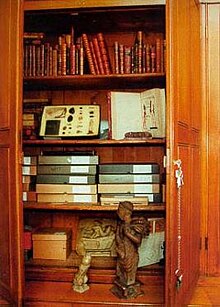| Secretum | |
|---|---|
 The Secretum in the latter part of the twentieth century, after its transfer to the Department of Medieval and Later Antiquities | |
| Housed at | British Museum |
| Size (no. of items) | c. 1,150 items |
| Funded by | |
The Secretum (Latin for 'hidden away') was a British Museum collection of the nineteenth and early twentieth centuries that held artefacts and images deemed sexually graphic. Many of the items were amulets, charms and votive offerings, often from pre-Christian traditions, including the worship of Priapus, a Greco-Roman god of fertility and male genitalia. Items from other cultures covered wide ranges of human history, including ancient Egypt, the classical era Greco-Roman world, the ancient Near East, medieval England, Japan and India.
Many of the early donations or sales to the museum, including those from the collectors Sir Hans Sloane, Sir William Hamilton, Richard Payne Knight and Charles Townley, contained items with erotic or sexually graphic images; these were separated out by museum staff and not put on public display. Modern scholars believe the segregation was probably motivated by a paternalistic stance from the museum to keep what they considered morally dangerous material away from all except scholars and members of the clergy. By the 1860s there were around 700 such items held by the museum. In 1865 the antiquarian George Witt donated his phallocentric collection of 434 artefacts to the museum, which led to the formal setting up of the Secretum to hold his collection and similar items.
The Secretum collection began to be gradually broken up in 1912, with the transfer of items into departments appropriate for their time frame and culture. The last entry into the Secretum was in 1953, when the British Museum Library found 18th-century condoms being used as bookmarks in a 1783 publication they held. The last remaining items were moved out of the collection in 2005.